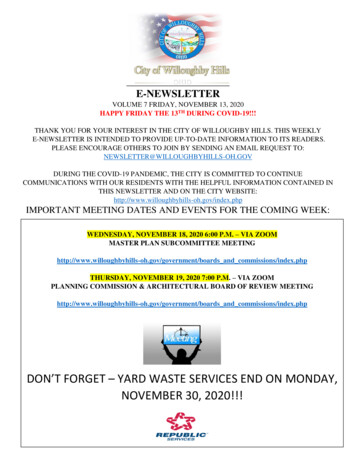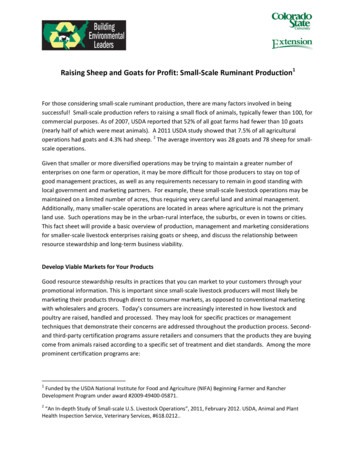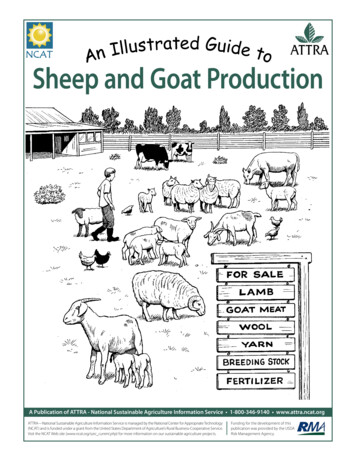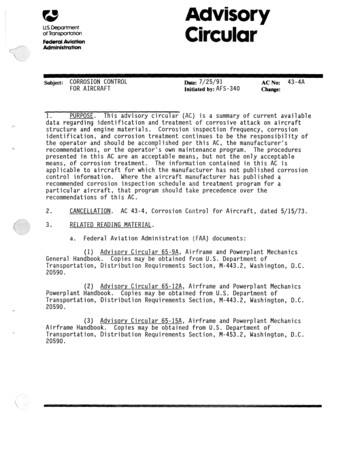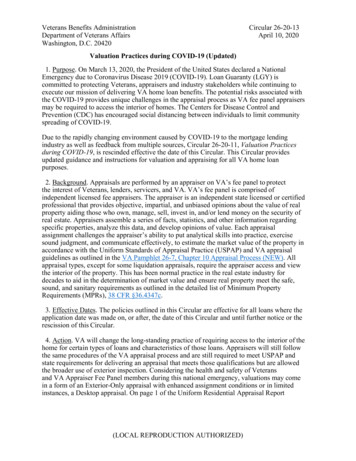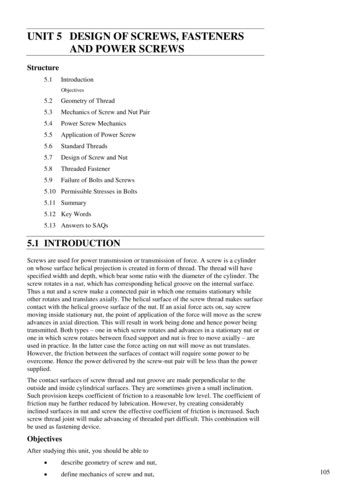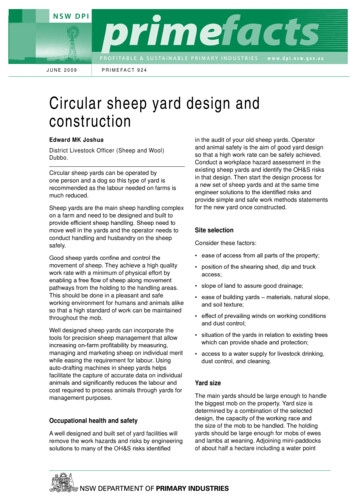
Transcription
jUne 2009P r i m e fA C T 9 2 4Circular sheep yard design andconstructionEdward MK JoshuaDistrict Livestock Officer (Sheep and Wool)Dubbo.Circular sheep yards can be operated byone person and a dog so this type of yard isrecommended as the labour needed on farms ismuch reduced.Sheep yards are the main sheep handling complexon a farm and need to be designed and built toprovide efficient sheep handling. Sheep need tomove well in the yards and the operator needs toconduct handling and husbandry on the sheepsafely.in the audit of your old sheep yards. Operatorand animal safety is the aim of good yard designso that a high work rate can be safely achieved.Conduct a workplace hazard assessment in theexisting sheep yards and identify the OH&S risksin that design. Then start the design process fora new set of sheep yards and at the same timeengineer solutions to the identified risks andprovide simple and safe work methods statementsfor the new yard once constructed.Site selectionConsider these factors:Good sheep yards confine and control themovement of sheep. They achieve a high qualitywork rate with a minimum of physical effort byenabling a free flow of sheep along movementpathways from the holding to the handling areas.This should be done in a pleasant and safeworking environment for humans and animals alikeso that a high standard of work can be maintainedthroughout the mob. ease of access from all parts of the property;Well designed sheep yards can incorporate thetools for precision sheep management that allowincreasing on-farm profitability by measuring,managing and marketing sheep on individual meritwhile easing the requirement for labour. Usingauto-drafting machines in sheep yards helpsfacilitate the capture of accurate data on individualanimals and significantly reduces the labour andcost required to process animals through yards formanagement purposes. situation of the yards in relation to existing treeswhich can provide shade and protection;Occupational health and safetyA well designed and built set of yard facilities willremove the work hazards and risks by engineeringsolutions to many of the OH&S risks identified position of the shearing shed, dip and truckaccess; slope of land to assure good drainage; ease of building yards – materials, natural slope,and soil texture; effect of prevailing winds on working conditionsand dust control; access to a water supply for livestock drinking,dust control, and cleaning.Yard sizeThe main yards should be large enough to handlethe biggest mob on the property. Yard size isdetermined by a combination of the selecteddesign, the capacity of the working race andthe size of the mob to be handled. The holdingyards should be large enough for mobs of ewesand lambs at weaning. Adjoining mini-paddocksof about half a hectare including a water point
increase the number of mobs that can be handledin a set of yards.Provide 1 m2 per three sheep in forcing areas andat least 1 m2 per sheep in holding areas. Sheep in the force should not be able to seebehind them. Closed panels on the back of thebugle-shaped force achieve this.LayoutDesignWhen designing sheep yards keep the followingpoints in mind: Sheep have wide angled vision – they can detectmovement behind them without moving theirheads. Sheep should have a clear, unobstructed viewtowards where they are meant to move. Whenever possible use wide gates to maintaingood sheep flow. Ideally sheep should take a familiar route anddirection through the yards for all handlingoperations. Entrances to sheds, loading ramp, and dipshould be placed along the route sheep usuallytake through the yards. Sheep move better on the flat than up or downhill. If the land slopes, the direction of movementshould be across the slope rather than up ordown hill. Sheep can cope well with one change of statusat a time – go up a ramp; go onto the flat landing;go through a gate; go around a corner; go intoa shed or a truck. Do not try to get sheep to domore than one change of status at a time orthey will have trouble and cause a blockage inmovement pathways. Sheep move readily towards light and avoid darkareas, shadows and dead ends. Sheep move willingly around curves and cornersinto narrow races. Sheep follow one another, and the use ofsee-through panels may encourage them to move. Take sheep behaviour into account whenpositioning handling facilities – generallysheep will move towards the receival yardsin anticipation of escape or release to theirpaddock. Oncoming sheep must not see the operator.Closed and slightly higher panels on theoperator’s side of the force obscure the viewof other sheep moving in the yards and theoperator. The sheep in the force focus on thesheep in front of them and in the direction ofmovement without distraction.2 primefact 924, circular sheep yard design and constructionThe overall layout of a sheep yard should havesome separation between holding areas andmovement pathways. The drafting race is led to bya curved force in a U-bugle, Y-bugle, D-shape orhalf circle yard. These are variants on the themethat sheep move in a circular motion in response toattack by a predator. The sheep flow patterns aresimilar in these curved designs using a curved forceleading from the holding area to the handling area.Sheep enter a separate race or a combined draftingand working race through a common bugle entry,as shown in Figure 1.A major advantage of circular yards is thecontinuous flow of sheep through the main handlingarea. The design uses the natural circling instinctof sheep to encourage them to keep moving.The bugle entry takes advantage of this and theoperator uses less labour moving about the yards.The curve of the bugle and the placement of thedrafting and working races allow the operator to beclose to the sheep at all times.Sheep move better if they always travel throughthe yards along a familiar route and in the samedirection from their paddock, through the yards andreturn to their paddock. Sheep learn the pathwayand are happy to move along it as a mob. Thecommon force can be used to deliver sheep to thescales, a handling machine, the drafting race, theworking race, the dip or the shearing shed. Thecircular design also delivers sheep back to an exityard.Circular yards do not need as much heavy dutyfencing as rectangular yards and substantial costsavings result due to the use of lighter materials forthe holding and receival areas. Heavy constructionis required in the force and main handling areaswhere sheep pressure is high.ConstructionPlanningSelect the best available site, and then choose aplan that suits it. Estimate the materials required,measure and list the types and lengths of postsand panels needed for the yards, races, gatesand loading ramp. Cost all materials and allowfor concrete where appropriate in the main sheephandling areas.
Figure 1. Bugle entry to drafting and working race showing dimensions for laying out the bugle. Dimensions in mm.Pegging outYards must be completely pegged out beforeconstruction begins. Peg all key structuresaccording to the plan in the following order: drafting race and bugle entry; working race and forcing area; main holding and receival yards; gateways.Position the key pegs first, and use a tape tomeasure, square and string line to place the restof the pegs. Start pegging from the drafting gatesand use Figure 1 to lay out the drafting race andbugle entry; then add the working race, the holdingand receival yards. Peg out the forcing, holding andreceival yards and all gateways before constructionbegins.Now walk through the yards to confirm that sheepwill be able to do so when construction is complete.It may be useful to squat down to get a sheep’s eyeperspective on the yard’s pathways to determineif closed or open panels are best used dependingon the view and movement of humans and sheepadjacent to that area. Think about how a sheepwill react to what you can see when the yards arebuilt and design yards that will facilitate good sheepbehaviour.BuildingCommence building with the sheep handlingareas and then add the forcing pathways and theholding and receival yards. Any mini paddocks andlaneways can then be built to suit your farm plan.Drafting raceGood drafting races allow sheep to be identifiedand separated with a minimum of error and effort.Continuous single-file movement of sheep isessential and three-way drafting is adequate forFigure 2. Cross section of a drafting race with inclinedsides. The design encourages smooth sheep flow.most properties. The following guidelines areprovided for building good drafting races. A drafting race is a straight run length of 3–3.5metres before the drafting gates, with closedpanels on both sides. Inclined sides in a ‘V’ shape works well with arange of sheep sizes and prevent sheep turningas their feet are close together. The race shouldbe 280 mm wide at the base, 550 mm wide at thetop and 900 mm high (Figure 2). A vertical sidedrace would be 450 mm wide. The floor should be of a durable surface likeconcrete or brick and drain water runoff to a pointwell away from the working area. The direction of the drafting race should minimisethe effects of sun and shade on the operator andprimefact 924, circular sheep yard design and construction 3
the sheep. A south to north direction with a flator slightly uphill grade works well. Races runningeast or west should be avoided due to the effectsof shadows.as the shearing shed or dip and on a north-southaxis to minimise the effects of shadows. Good drainage away from the working race isimportant. Drafting gates should be 1.2 m long with openrails as they allow better vision and are light,quick and easy to use. Use a working race length of 10–15 m. Where alarger capacity is required consider a dual race. Set the handles on drafting gates 150 mm backfrom the front of gates so that the operator’sknuckles are free as the gates come together. The width depends on whether the operator prefersto work inside (narrower) or outside (wider) therace. Fixed races are built 500–700 mm wide;adjustable races vary from 500–800 mm wide. A hand-guard (150 mm pipe) welded at thevery front of the gate will help prevent collisionsbetween exuberant sheep and the operator’sknuckles. The width between the drafting gates rangesbetween 450 mm with a non adjustable race and520 mm with an adjustable race.In circular yards with a bugle entry to the draftingrace, use closed panels to prevent sheep fromseeing the operator. It is advantageous to have theback of the forcing area made of a closed panelto encourage sheep to move forward through thedraft.The various circular designs use the principle ofcircular sheep flow: Rails should be 850–900 mm high. An openconstruction of pipe timber or metal rails isrecommended (Figure 4). The floor should have a durable surface ofconcrete or brick 75–100 mm thick and a slightslope for drainage at ground level; or a raisedtimber or metal mesh grating 250 mm aboveground level. The floor should extend at least 300 mm beyondthe width of the race to provide a walkway for theoperator. A drafting gate at the end of the working raceenables drafting after working on the sheepwhich can be an advantage.‘U’ bugle design (Figure 5)‘Y’ bugle design (Figure 6)‘D’ bugle design (Figure 7)Bugle with curved working race (Figure 8).These are compared with the traditional rectangularsheep yard design (Figure 9) on page 10.Working raceThe working race is used frequently and is the focalpoint of many sheep handling activities. A well builtrace will have a long life and provide for a safe andcomfortable working environment.Use the following guidelines when building aworking race: Roofing or shade from trees provides betterconditions for the conduct of physical labourand eliminates the contrasts of light and shadow(Figure 4). The installation of a two-way drafting gate at theend of the working race facilitates drafting afterhandling such as classing, mouthing, wet/dry/lambed and lost. Ideally the working race should be located sothat sheep are moving away from structures such4 primefact 924, circular sheep yard design and constructionFigure 3. A working race for handling rams with horns.Note: top rail design and drafting gates at the head andtail of the working race.
Figure 4. Cross section of a working race. Roof creates pleasant conditions and eliminates contrasts of light andshadow.In circular-design yards with a separate workingrace, the same bugle entry is used to fill all handlingraces from the one forcing area. This is efficientas sheep take the same route and direction for allprincipal handling activities.MaterialsThe materials you select will depend uponavailability, cost on site, ease of erection, availabilityof construction labour and likely maintenanceproblems. The most common materials used aretimber and steel. Fences may be made entirely oftimber, especially if durable species are availableon the property. Alternatively they may be madeentirely of steel or various combinations of timberand steel. Conveyer belting is a useful fence in highpressure areas as it is quiet during operation.Fence height is a compromise between confiningsheep and providing convenient access foroperators and their dogs. Perimeter fences aregenerally 1 m high and internal fences are 900mm high. Gates for operators provide convenientaccess along movement pathways when higherfences are used.The ability of the fence to withstand the pressure ofsheep in the yards depends mainly on the materialsused and how they are assembled. The stability ofthe fence posts depends on the soil’s resistanceprimefact 924, circular sheep yard design and construction 5
Figure 5.6 primefact 924, circular sheep yard design and construction
Figure 6.primefact 924, circular sheep yard design and construction 7
Figure 7.8 primefact 924, circular sheep yard design and construction
Figure 8.primefact 924, circular sheep yard design and construction 9
Figure 9.10 primefact 924, circular sheep yard design and construction
to the force applied to it; with steel posts, settingthem in concrete is one way of increasing the areathat is in contact with the soil. General fence postsare set into the ground to a depth of 500–600 mm.Increase the depth to 900 mm for main gate postsand posts in the forcing yards.Post spacing is in the range of 1.8 m to 3.0 mfor straight fences, however in sections of yardswhere there is crowding the spacing may need tobe reduced. It may also be necessary to put postscloser together for correct curvature in circularyards.Material dimensions commonly used: Round or split bush timber – 100 to 150 mm thickfor rails and 200 to 250 mm thick for posts. Sawn timber 150 x 25 mm or 100 x 38 mmhardwood rails and 100 x 125 mm hardwoodposts. Black or galvanised pipe or tube – 20NB or25 NB rails and 40 NB or 50 NB posts set inconcrete. Steel may corrode at ground level sobuild concrete footing up to keep posts dry. Steel belted rubber conveyor belting can beattached to a pipe fence 75 mm below the top railand 100 mm above floor level.Figure 10. Spacing of pipe rails and timber rails for sheep yard fences.primefact 924, circular sheep yard design and construction 11
Prefabricated galvanised mesh panels – 3 mlong and 900 mm high, bolted to steel posts. Combination of steel mesh, steel or timber topand bottom rails and treated timber posts 75 to100 mm diameter.GatesGateways should be wide to allow smooth sheepflow and movement around yards. Gates may bebuilt from timber or steel or combinations of the two.They should be hinged so they are quick and easyto operate.Gate catches should be easy to maintain andsimple to operate. Chain and slot, tongue and slot,chain and loop and sliding bolt are all examples ofeffective gate catches.Yard surfaceThe yard surface needs to be solid, durable andwell drained so that sheep movement is continuouson a firm surface.Handling races may be surfaced with concrete,brick, timber or metal grating. Sheep pathways maybe surfaced with concrete, brick or gravel.Holding yards may be surfaced with gravel if theexisting soil type is unsuitable. Alternatively thestability of clay soils can be increased by thoroughlymixing 3 per cent builders lime (calcium oxide ineither burnt or hydrated form) with the top 15 to 20mm of soil. The soil must then be compacted witha heavy roller, sheep’s foot roller or vibrating platecompactor.WaterFresh drinking water must be available if sheepare to be held in yards or mini paddocks for morethan a day. Water points and a sprinkler system areuseful if dust is a problem and a supply of watermay also be required if dipping and jetting are tobe conducted in or near the yards. Water is usefulfor cleaning equipment used in the yards and whenoperators need to wash themselves or animals for avariety of reasons.Associated handling facilitiesLoading rampSheep can be loaded quickly and effectively fromground level with an effective loading ramp. Aforcing area is needed to simplify the handlingof the sheep up the ramp; it may be the same12 primefact 924, circular sheep yard design and constructionFigure 11. Loading ramps need to be able to suit thetype of vehicle used for sheep transport.forcing area used for drafting and working races, oranother separate force used for loading.The loading ramp can be constructed as apermanent fixture with height adjustment. It isimportant to have a walkway along one side to givethe operator access to sheep as they are beingloaded.A suitable loading ramp is 5 m long and 450 mmwide with sides 900 mm high. It should be 1.2metres high for single-deck livestock transports,and adjusted to 2.1 metres over 10 m for doubledeck transports.DipA dip can be located close to the main pathway sothat sheep can easily be diverted to the dippingarea. Plunge dips are thorough but labour intensive.Avoid an easterly sheep flow into the dip becausethe sun shining on wet concrete draining pens maybalk sheep and hinder entry. A section of timber ormetal grating leading up to and at the entrance ofthe dip will reduce contamination of the dip washwith faeces and dirt.
Figure 12. A roof will provide shade and protection from the elements for all animals and humans working in thefacility, providing a safe work environment.Shearing shedDeciduousThe entrance pathway into a shearing shed may belocated close to the main sheep handling area ofthe yards. A wide entrance where sheep can moveinto the shed as a mob on level footing is preferred.Desert ash (Fraxinus oxycarpa)Syrian ash (Fraxinus syriaca)It may be convenient to have shorn sheep deliveredfrom count out pens to the sheep handling races fordrafting or husbandry operations.ShadeSome deciduous and evergreen trees that aresuitable for the purpose are:White cedar (Melia azedarach)Umbrella cedar (Melia azedarach cv.Umbraculiformis)Black locust (Robinia pseudoacacia)Working conditions in sheep yards are improved ifthere are trees to provide shade during summer.Yards are often built around existing trees andmore trees are planted in select locations to provideshade and better working conditions. Ideally theyshould be fast growing and deciduous to provideshade in summer and sun in winter for warmth andto facilitate drying.When deciding which species to use consider soilfertility, rainfall and frost incidence. Don’t planttrees with large limbs which can be hazardous tolivestock and operators.Thornless honey locust (Glenditsia triacanthos var.Inermis)EvergreenBlue mallet (Eucalyptus gardneri)Yorrell (Eucalyptus gracilis)Paddy’s river box (Eucalyptus macarthurii)Sargent’s mallet (Eucalyptus sargentii)Swamp mallet (Eucalyptus spathulata)Green mallee (Eucalyptus viridis)Wilga (Geijera parviflora)Pepper tree (Schinus areira)Further information on tree species suitable forstockyards is available from NSW DPI – Forests NSW.primefact 924, circular sheep yard design and construction 13
Shade can be provided
similar in these curved designs using a curved force leading from the holding area to the handling area. Sheep enter a separate race or a combined drafting and working race through a common bugle entry, as shown
